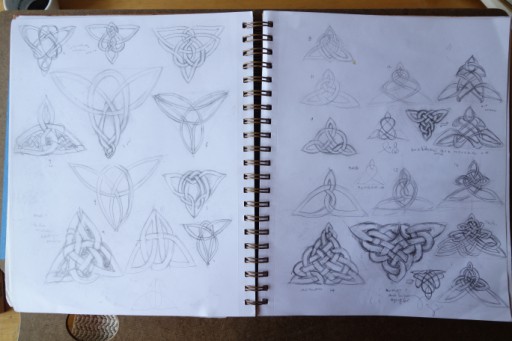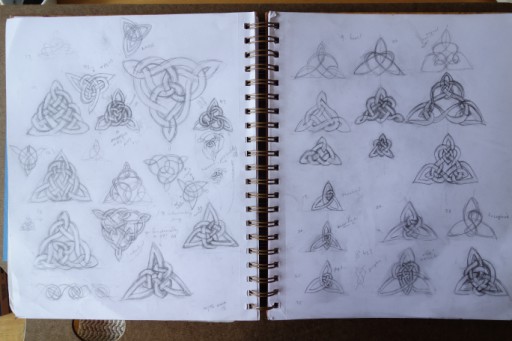I have perhaps told this story on the blog before, [1] but allow to go into a little more detail. When I took the survey course required for majors, and my art history prof projected what is now called Insular art, but what my text referred to as Hiberno-Saxon and which honestly everybody then and now calls celtic on a huge screen...and I was entranced.
Literally.

practice sketches. Most based on Ardan Meehan's appendix, with some original designs. Graphite, March 2015.
I ran—not walked— ran to the library to get books on this stuff. I will be forever grateful to my prof for showing multiple examples; my text, the 7th edition Gardner, does at least show that fabulous Lindesfarne carpet page in full-color, in a full-page reproduction; the text, meanwhile blathers on about barbarians who can't get their figurative/3-dimensional ducks in a row, reducing folds and realistically rendered flesh into mere “patterns”.[2]

practice sketches. The one on the right was the first I made in this sketchbook; the left, my latest effort, as of 21mar15. Graphite, March 2015.
Although I love patterns, and have wanted to learn how to do this ever since, it took years before I found a working method. I've alluded to this before—it took me at least three tries before I really “got” how to do French beaded flowers. Other techniques/media have required this circling back for multiple retries as well.

practice sketches. Most based on Ardan Meehan's appendix, with some original designs. Graphite, March 2015.
The fact that I wasn't doing much drawing for a decade or two probably had something to do with it as well:) Celtic interlace can and has been used very effectively in other media (notably, carving) but I've always considered it a graphic technique.
[1](last year about this time, "in fact")—update, 14apr2018: actually, I went back in checked: no.
[2]Needless to say, the man most clearly associated with the a successful melding of western painting and patterns ultimately derived from celtic interlace—Alphonse Mucha—doesn't get so much as a mention.
Unless otherwise noted, text, image and objects depicted therein copyright 1996--present sylvus tarn.
Sylvus Tarn